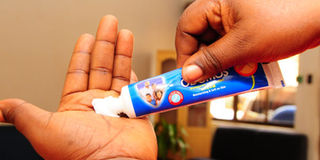The money in mosquito repellant

A person applies mosquito repellant cream on her hand. People who feel uncomfortable sleeping under mosquito nets can switch to repellant creams. Photo by Rachel Mabala
Since there are many mosquito-infested areas in the country, you can invest in mosquito repellants considering that malaria is one of the killer diseases in Uganda. Dorothy Nakaweesi shows how this makes business sense.
Aside from their small size, mosquitoes are irritating especially when people are trying to sleep.
The tiny flying bloodsuckers during their active breeding months are a menace because they transmit malaria parasites through biting.
That is why investing in mosquito repellant makes business sense. Making mosquito repellant will prevent people from falling sick while you are minting money at the same time.
Repellant creams or call jelly when applied on your skin like the other normal creams will leave your skin soft while keeping away the mosquitoes.
Experts say that when the repellant cream is applied on the most visible parts of the body –the cream remains effective for more than 12 hours.
Capital
So then, if you want to invest in this business, you need about Shs2.2 million ($629) worth of fixed capital.
The operation capital in the first year is estimated about Shs304 million ($84,566). This will generate you revenue worth $126,000 (Shs453 million) in the first year of operation. This means your monthly earnings will be about Shs37.7 million with a net profit margin of 33 per cent.
Mr Charles Ocici, the executive director Enterprise Uganda, in an interview with Prosper magazine, said: “Producing mosquito repellant cream is an easy business to break into the market because of its relatively little starting capital and not so sophisticated technology.”
Production process
The production process involves heating and melting of snow white petroleum jelly in a stainless steel air-tight vessel.
When it reaches a boiling point, mosquito repellent essential oil is then added and allowed to mix thoroughly.
At this stage, you may add colour and the solution is then packed in plastic containers and placed on trays to cool. The containers are later cleaned, labeled and packed in dozens and sealed for dispatch to the market.
Incentives
Experts say usually the production costs assumed are 312 days per year with daily capacity of producing 3,500 to 150mgs of repellant cream.
According to Uganda Investment Authority, after four years of operation all the assets will be given a 25 percent annual tax waver.
Direct costs include: materials, supplies and other costs that go into producing the product.
Market
Since there are many mosquito-infested areas in the country, the market for mosquito repellants is wide considering that malaria is one of the killer diseases in Uganda.
People who feel uncomfortable sleeping under mosquito nets can switch to repellant creams.
Advice
Mr Ocici advises that before you invest in this business, research about the unit cost price to attract clients.
“When you produce repellants, don’t concentrate on Kampala alone; make sure your product can be accessed countrywide,” he shared.
Because there are other alternative products which are used to eliminate mosquitoes like insecticide sprays and essences, Mr Ocici says you need a creative marketing team with good convincing tactics to attract customers.
The risk involved in this business is that some people may be allergic to ingredients in the repellent.




